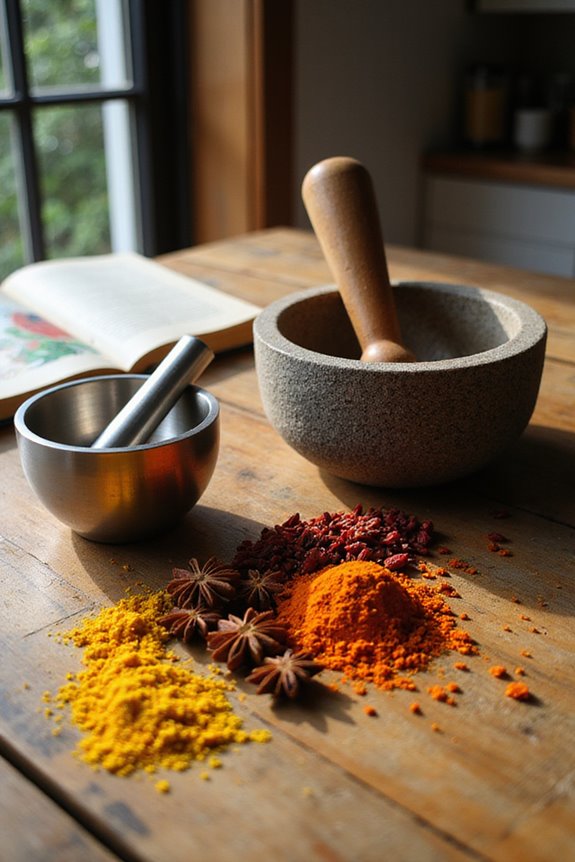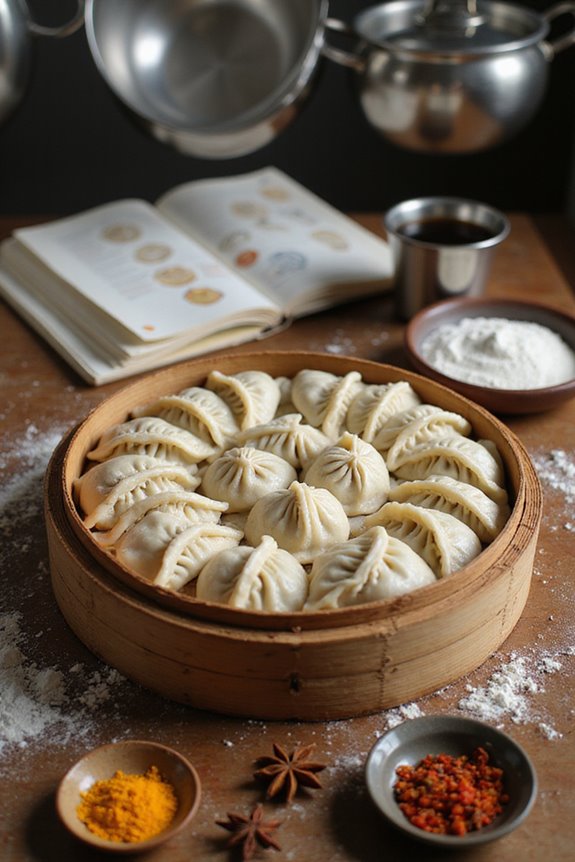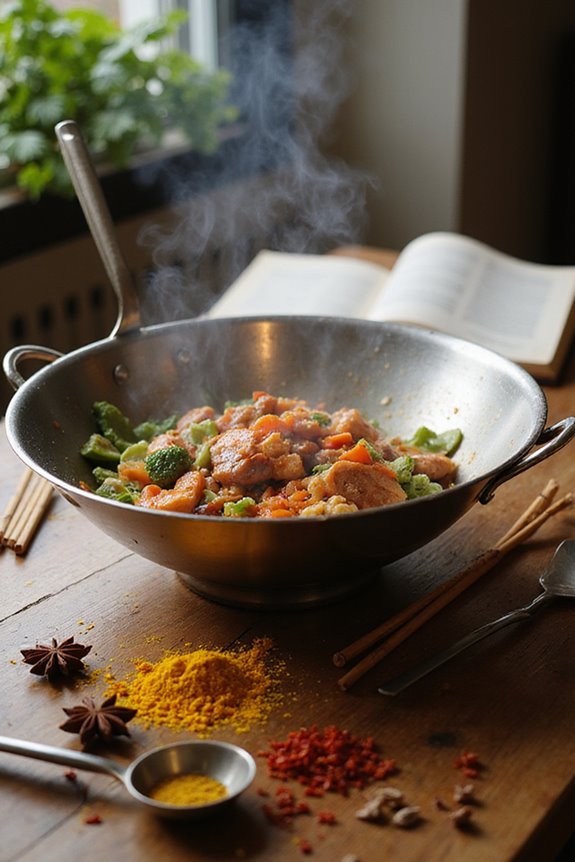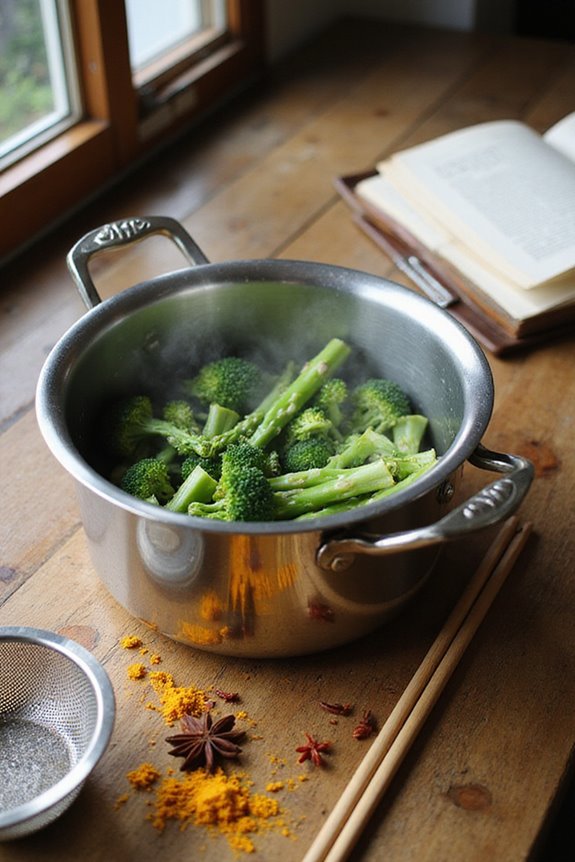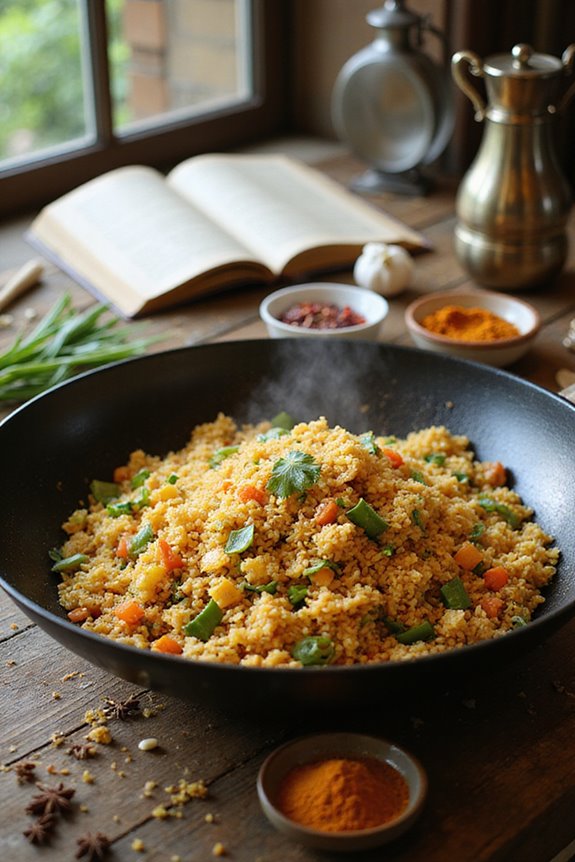When we’re cooking, grinding and pounding are like magical spells for our ingredients! Grinding crushes and pulverizes for a silky finish, perfect for sauces and spices. It’s all about those fine, uniform particles! Pounding, on the other hand, delivers delightful, chunky textures, ideal for rustic dishes. Think of it as a strong hug for grains! Both methods add wonderful flavors and preserve nutrients. Want to uncover more about these techniques? Let’s keep exploring!
Key Takeaways
- Grinding involves crushing ingredients into fine powders or pastes, while pounding delivers direct blows for coarser textures.
- Pounding is traditionally used in communal cooking, whereas grinding often enhances the texture of baked goods.
- Grinding produces uniform particles for smooth sauces, while pounding retains chunky bits for a rustic finish.
- Mortar and pestle are common manual tools for both techniques, with grinding providing versatility and pounding focusing on ingredient integrity.
- Both methods enhance flavors and textures while preserving nutrient content in various cuisines, especially in Asian cooking.
Definition and Basic Differences
When we think about cooking, the terms “grinding” and “pounding” can sound a bit magical, like transforming ordinary ingredients into something extraordinary! Let’s break down these techniques:
- Pounding Mechanics: This involves delivering repeated, direct blows to break up ingredients—think of a heavy mallet at holiday baking!
- Grinding Efficiency: Here, we’re crushing, rubbing, and pulverizing our ingredients into fine powders or pastes.
While pounding is a forceful impact action, grinding focuses on friction and continuous abrasion. Pounding keeps textures coarser, while grinding gives us delightful smoothness. Key ingredients from Asian cooking often benefit from both methods to enhance flavors and textures. Remember, both techniques bring their own charm to the kitchen. So, whether you’re dehusking grains or making your own flour, embrace these methods and enjoy the journey!
Purpose and Applications
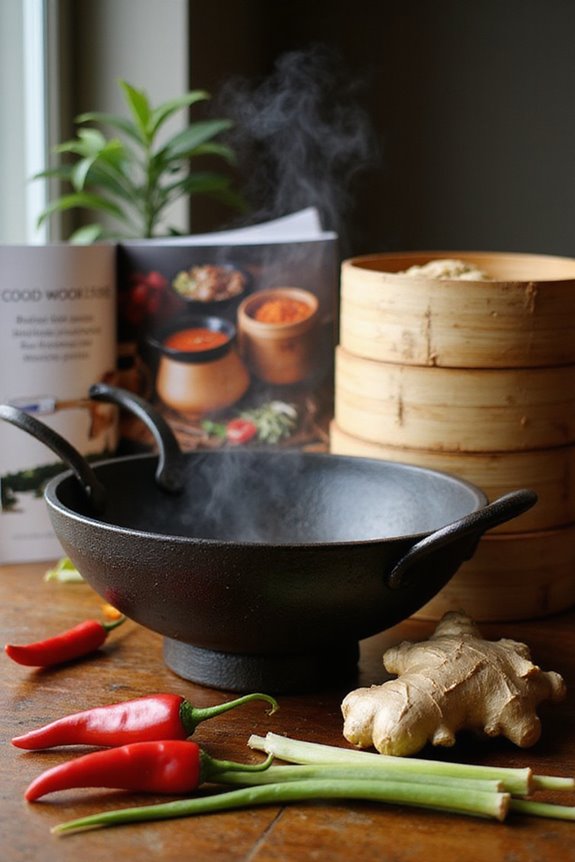
In the culinary world, understanding the purpose and applications of grinding and pounding can really add some magic to our cooking adventures!
Grinding is all about:
- Breaking down grains and seeds into fine particles, enhancing their bioavailability.
- Creating delightful textures for baked goods and meals.
Pounding serves a different purpose:
- It removes hulls from grains, keeping their delightful textures intact.
- It’s a traditional method, often used in communal cooking settings.
Both techniques help with nutrient preservation by maintaining the integrity of our favorite ingredients. So, whether we’re crafting the perfect flour for cookies or preparing rustic grain dishes, knowing when to grind or pound can elevate our culinary techniques. Additionally, using non-stick surfaces can help in the grinding process, making it easier to achieve the desired texture without sticking. Let’s embrace these methods and savor the delightful results!
Equipment and Techniques
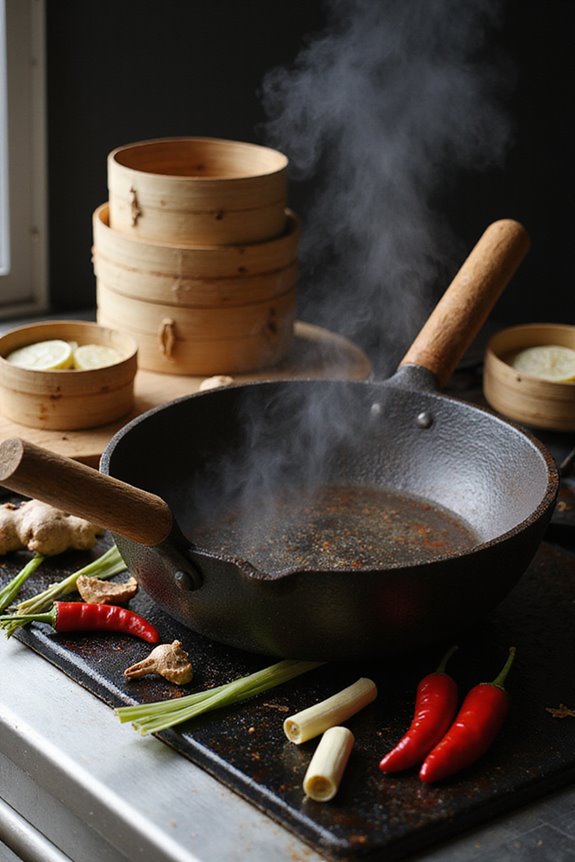
Equipment and techniques are the backbone of our culinary adventures, turning simple ingredients into delightful masterpieces! Let’s explore the tools that help us succeed.
Grinding Machines:
- Bench Grinders: Perfect for sharpening; they come in various wattages (500–3,000W).
- Precision Grinders: For the perfect shape; they can cost between $1,000 and $100,000!
Pounding Methods:
- Mortar and Pestle: Our trusty manual tool; you can crush spices easily.
- Pounding Machines: Ideal for grains; they deliver powerful, repetitive strikes.
Whether we’re grinding or pounding, these techniques help us create flavorful dishes. Using fresh spices enhances flavor and aroma, making every bite turn into a magical holiday feast! So, let’s roll up our sleeves and get to work!
Particle Size and Product Outcome
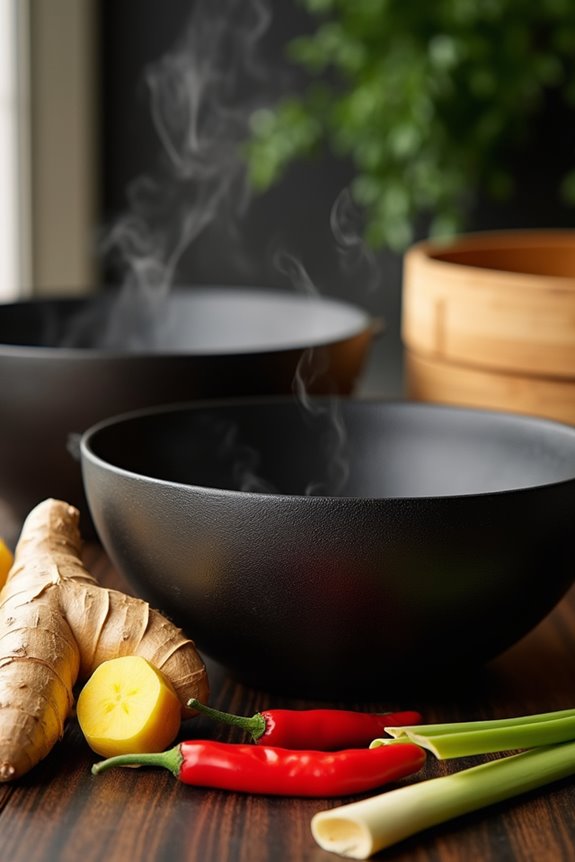
Shifting our focus from the equipment and techniques, let’s dig into the fascinating world of particle size and how it affects the quality of our culinary creations.
- Grinding gives us fine, uniform particles—think silky sauces and perfectly blended spices!
- Pounding, on the other hand, creates a delightful rough texture with chunky bits.
As we mix and match, remember:
- Consistent particle size boosts product quality, ensuring smoothness and flavor.
- Using a grinder can be magical for precise textures needed in baking, while pounding might be just right for rustic dishes. Additionally, experimenting with air fryer techniques can transform classic flavors and textures in your cooking.
Next time we’re cooking, let’s consider how these methods influence our ingredients’ particle size and, ultimately, the deliciousness of our fluffy holiday treats! Happy cooking!
Historical and Cultural Context
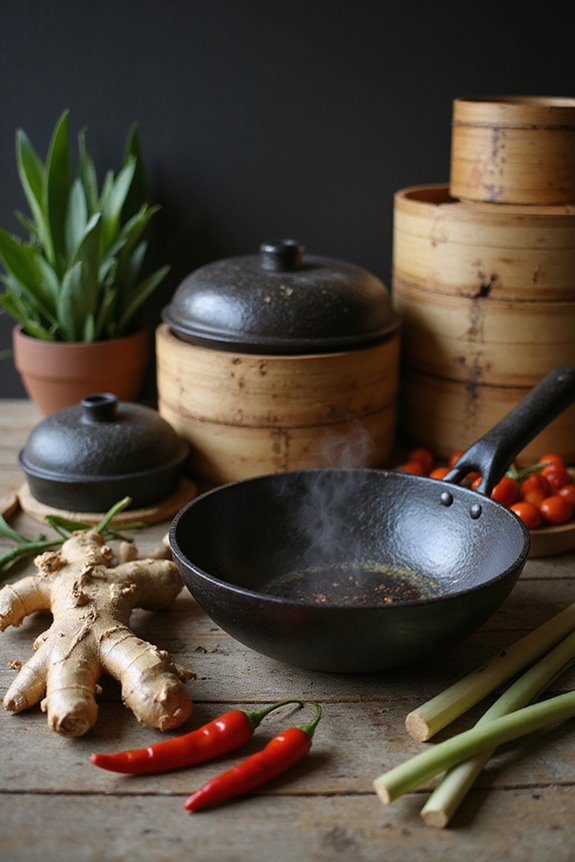
Grinding and pounding aren’t just kitchen techniques; they hold rich historical and cultural significance that’s fascinating to explore! From ancient Indian rock paintings to Aboriginal grinding stones that date back 15,000 years, these historical tools tell stories of our ancestors. They reflect cultural significance, often indicating gender roles, as grinding was typically a woman’s task.
- Cultural Artifacts: Tools like the mortar and pestle show the variety across cultures.
- Physical Impact: These methods shaped lifestyles and economies for generations. Additionally, the health benefits of naturally ground spices can enhance our meals and nutrition.
Understanding these traditions can deepen our connection to food. So, the next time we grind spices or pound herbs, let’s celebrate the delightful history behind our actions. It’s a magical link to those who came before us!
Frequently Asked Questions
Can Pounding Be Used for Modern Food Processing?
Absolutely, we can still use pounding techniques in modern applications! While efficiency often reigns, certain artisanal foods benefit from the unique textures pounding provides, connecting us to culinary traditions and enhancing our cooking experience together.
Which Method Is Faster: Grinding or Pounding?
When we explore the speed comparison and efficiency analysis between methods, we find grinding’s our go-to for quick meat processing. It outpaces pounding in speed, consistency, and overall performance, making it the favored choice for us.
Are There Any Health Benefits to Pounding Food?
Absolutely, we’ve found that pounding benefits our physical and mental health. This culinary technique helps us control ingredients while bonding as we prepare meals, promoting mindfulness and a greater appreciation for our food together.
What Types of Grains Are Best for Grinding?
When we explore grain types for grinding, we find hard red, soft white, and even ancient grains shine. Through various grinding techniques, we can reveal incredible flavors and fresh nutrients for our favorite recipes together.
Is Traditional Pounding Still Practiced Today?
Yes, traditional pounding’s still practiced today! We cherish its cultural significance, connecting us to our heritage. By embracing these traditional techniques, we celebrate flavors and textures that modern methods often overlook, enriching our culinary experiences together.

